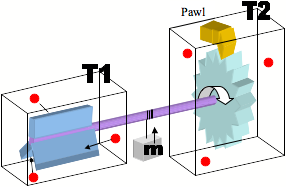Brownian ratchet (nonfiction): Difference between revisions
| (One intermediate revision by the same user not shown) | |||
| Line 18: | Line 18: | ||
== Nonfiction cross-reference == | == Nonfiction cross-reference == | ||
* [[Brownian motion (nonfiction)]] | |||
* [[Maxwell's demon (nonfiction)]] | * [[Maxwell's demon (nonfiction)]] | ||
* [[Physics (nonfiction)]] | * [[Physics (nonfiction)]] | ||
External links: | External links: | ||
Latest revision as of 00:20, 18 December 2016
In the philosophy of thermal and statistical physics, the Brownian ratchet or Feynman-Smoluchowski ratchet is a thought experiment about an apparent perpetual motion machine.
It was first analysed in 1912 by Polish physicist Marian Smoluchowski, and later popularized by American Nobel laureate physicist Richard Feynman in a physics lecture at the California Institute of Technology on May 11, 1962, during his Messenger Lectures series The Character of Physical Law in Cornell University.
The simple machine, consisting of a tiny paddle wheel and a ratchet, appears to be an example of a Maxwell's demon, able to extract useful work from random fluctuations (heat) in a system at thermal equilibrium in violation of the second law of thermodynamics.
Detailed analysis by Feynman and others showed why it cannot actually do this.
In the News
Fiction cross-reference
Nonfiction cross-reference
External links:
- Brownian ratchet @ Wikipedia
Schematic figure of a Brownian ratchet (Feynman-Smoluchowski ratchet), a simple hypothetical mechanism used in a thought experiment by Marian Smoluchowski and Nobel laureate Richard Feynman to demonstrate the laws of thermodynamics.
The device is a tiny paddlewheel attached to a ratchet. It appears to be an example of a Maxwell's Demon, able to produce useful work from the random thermal motion of molecules at a constant temperature in violation of the Second Law of Thermodynamics. Feynman and others showed why it cannot actually produce work if T1 = T2
Attribution:
